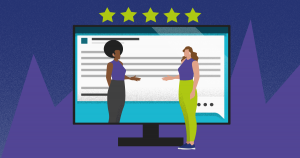SEO is key in any Digital Marketing strategy.
After all, who wouldn’t want to show up within the top organic search results on Google?
It’s where users find the most visible links, as well as those most frequently accessed by users.
Having a good SEO strategy can get you there!
Your site, blog, or eCommerce business becomes more well-known, resulting in authority in the market, a greater number of visitors, and increased conversion opportunities.
Best of all? You can achieve all of this without having to invest in paid advertising.
Through optimizations on your own pages and connecting to other sites, you can improve your users’ search and navigation experience.
With this complete guide to SEO, you’ll learn all you need to know to reach the top results on Google. We’ll cover the following topics:
Download this post by entering your email below
Ready to get started? The time has come to master SEO!
What is SEO?
SEO, or Search Engine Optimization, is a set of optimization strategies for sites, blogs, and pages on the web, which aim to improve your position in organic search engine results.
Every second, millions of searches are being processed by search engines — mainly Google, the most popular search engine around the world.
Users are looking for answers to an incredible range of questions in their daily routine – from the best-rated hotel for an upcoming trip to an explanation of the theory of evolution.
For every search, Google organizes the results by ranking the best answers first. The numbers below show just how much users trust the judgment of search engines:
- The first three organic links receive approximately 30% of all click-throughs.
- Only 0.78% of users access a link on the second page of the results.
Take a look at the graph below to see the correlation between position ranking and the number of clicks:
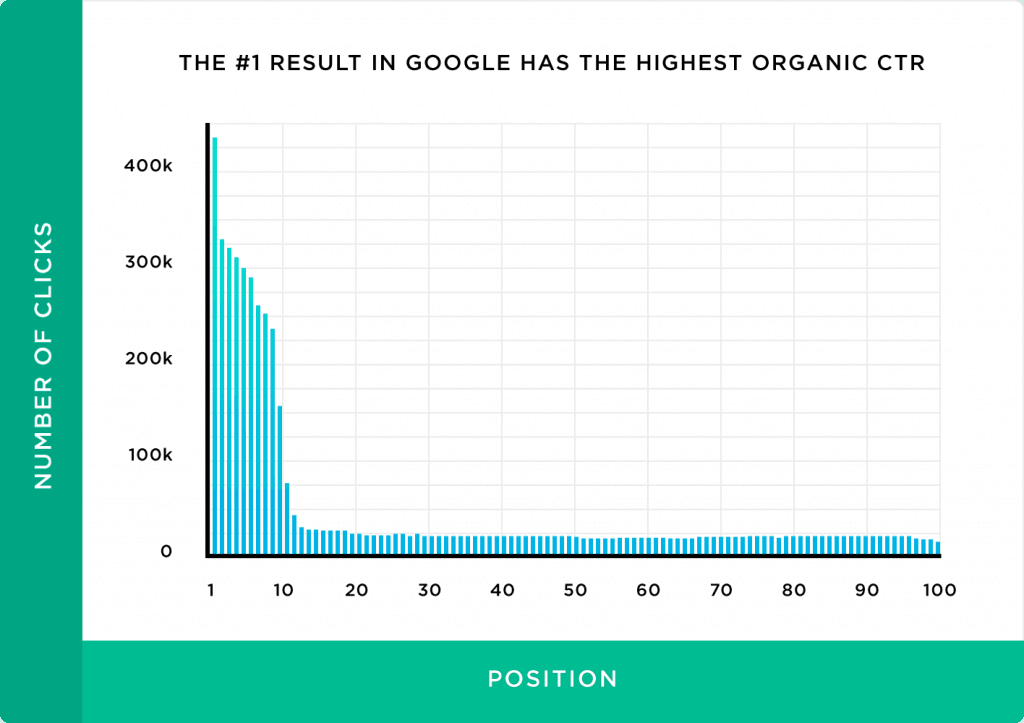
Every search presents the opportunity for your brand to offer the best response to what users are looking for.
With this as your focus, you have a better chance to increase your visibility and clicks, receive more organic traffic, and escalate results with your online presence.
But, to achieve this, you need to prove to Google that you have the best answer and deserve to show up in the first position on the SERP (Search Engine Results Page).
This involves not just having great content, but offering usability, communicating marketplace authority, and helping Google read your pages.
These are the goals of an SEO strategy.
SEO also plays a role in SEM (Search Engine Marketing), which covers all search engine strategies, including paid ads and sponsored links.
On the other hand, SEO only makes use of organic strategies and doesn’t encompass media purchases. This results in a higher return on investment (ROI) and lower customer acquisition cost (CAC).
What are Search Engines?
Search engines are systems or algorithms used to crawl, index, and rank web content to display it in an ordered way based on user searches.
When we refer to search engines, we’re not just talking about Google, but also Bing, Yahoo!, Baidu and others.
Even YouTube and Pinterest can be thought of as search engines since they’re often used to discover content.
But Google is the clear category leader, with almost 92% of the search market share.
Each search engine has its own methodology and ranking criteria. But in the end, the goal is always the same: offering the best results for what users are looking for.
How do Search Engines Work?
Have you ever considered exactly what Google does when you search for something? Despite only taking milliseconds, there’s a long process to be able to display a list of results that answer your question.
In general, search engines have three stages:

First, search engines crawl through web content using bots, also known as spiders. At Google, it’s known as their Googlebot. These bots follow the connections of links across the web, searching for new and updated pages.
After that, the crawled pages are added to the search engine’s index, which serves as a vast library for the web’s content.
There, pages are organized according to the information the bot collected about them, such as loading time and keywords.
These processes of crawling and indexing are continuously taking place.
The bots are always finding and organizing the content on the web. But the order in which they display their results to users is defined through ranking.
Ranking occurs every time a user searches for something — this is the focus of SEO.
According to the keywords used in the search, Google quickly goes through its index to find pages that coincide with those terms and respond to the question.
Thus, classification is determined by the best relationship between keywords and a series of ranking factors that make up the search algorithm.
They serve to offer a better user experience and, as a result, increase your page’s position in the search results.
We will focus on these factors in detail below.
Google’s Algorithm and Updates
Google’s algorithm is the combination of operations that define how links are classified on the organic search results page. Its function is to create a hierarchy of pages to provide results in the most relevant order for each user.
The algorithm adopts a series of criteria to achieve this and is continuously updated to become more and more relevant.
Through these updates, Google aims not just to improve the classification of results but also to eliminate or decrease the position of malicious and low-quality content, which can harm the user experience.
Thousands of updates occur every year, but several stand out for their impact on the SEO market.
These were the key updates to Google’s algorithm in recent years:
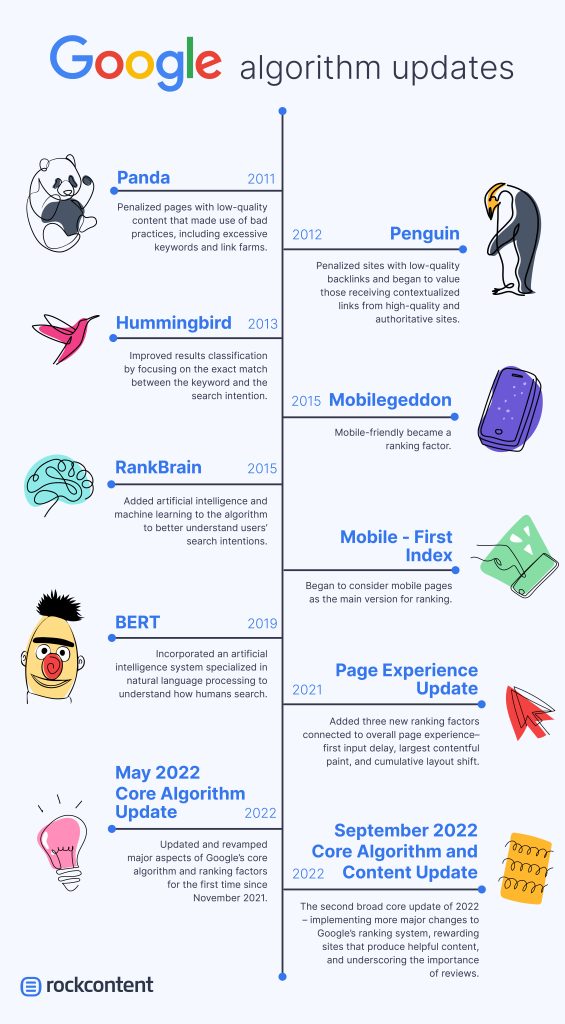
- Panda (2011): penalized pages with low-quality content that made use of bad practices, including excessive keywords and link farms.
- Penguin (2012): penalized sites with low-quality backlinks and began to value those receiving contextualized links from high-quality and authoritative sites.
- Hummingbird (2013): improved results classification by focusing on the exact match between the keyword and the search intention.
- Mobilegeddon (2015): mobile-friendly became a ranking factor.
- RankBrain (2015): added artificial intelligence and machine learning to the algorithm to better understand users’ search intentions.
- Mobile-First Index: began to consider mobile pages as the main version for ranking.
- BERT (2019): incorporated an artificial intelligence system specialized in natural language processing to understand how humans search.
- Page Experience Update (2021): Added three new ranking factors connected to overall page experience – first input delay, largest contentful paint, and cumulative layout shift.
- May 2022 Core Algorithm Update (2022): Updated and revamped major aspects of Google’s core algorithm and ranking factors for the first time since November 2021.
- September 2022 Core Algorithm and Content Update (2022): The second broad core update of 2022 – implementing more major changes to Google’s ranking system, rewarding sites that produce helpful content, and underscoring the importance of reviews.
Ranking Factors
It’s estimated that Google’s algorithm involves more than 200 ranking factors. The relationship between them determines the position on SERPs.
Google doesn’t publically share these factors but has made some statements that reveal some secrets. Moreover, the market itself performs studies to determine the impact of specific actions on-page ranking.
In general, we know that there are two types of ranking factors: on-page and off-page.
On-page ranking
On-page ranking factors are located on their own pages. When on-page SEO is mentioned, it’s referring to the optimization of these elements.
Some examples:
- Content
- Title and meta description
- Heading tag
- Images
- URLs
- Rich snippets
Google evaluates these factors to understand what information the pages offer and, therefore, how to index them correctly.
In addition, the search engine analyses if the page is offering a good user experience with relevant information.
Off-page SEO factors
Off-page factors, on the other hand, are elements that demonstrate the page’s status as a reference but are not located in the content of the page.
Off-page SEO consists of optimizing the site’s authority to users and other websites, with a focus on acquiring backlinks.
Some examples of these factors are:
- Number of backlinks
- Diversity of backlinks
- Context of backlinks
- Brand mentions
- Social signs
- Direct search
For Google, factors along these lines reveal a site’s level of authority.
If a page receives many visitors via direct searches for a brand name and many backlinks or mentions from trusted sites, it’s considered more authoritative in the market.
Black Hat SEO vs White Hat SEO
Google’s algorithm is always improving the search experience for users.
This means that it is not just continually improving search results, but also combating dubious and low-quality content, known as Black Hat SEO.
Black Hat strategies have been a target of Google since the early days of SEO.
When the algorithm was still new and had a lot of loopholes, it was easy to cheat the system to get a higher ranking, even if you had nothing to offer.
Common Black Hat strategies included:
- Doorway pages: pages optimized to redirect users to malicious pages
- Cloaking: pages that present different content to real users and bots
- Link farms: pages that only contain backlinks to other pages
- Keyword stuffing: pages excessively repeating keywords
- Hidden texts and links: pages hiding text and links from the user, but not from bots
- Comment spam: pages that comment on blogs to gain backlinks
In the example below, you can see code configured to hide keywords by using text set to a font size of 0 and the same color as the background:
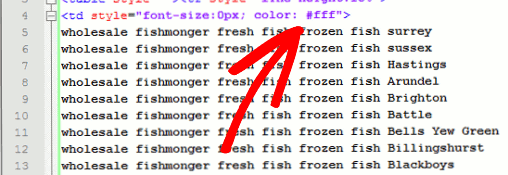
Strategies like these still exist. However, Google’s algorithm is increasingly complex and more intelligent at identifying Black Hat SEO.
For example, a massive increase in backlinks from suspicious domains over a short period of time is an indication of Black Hat techniques.
When this happens, pages are penalized, which can range from a temporary drop to a complete ban.
So, avoid Black Hat SEO.
If you want to earn the trust of search engines to guarantee a safe and sustainable position on SERPs, follow Google’s SEO guidelines.
These guidelines coincide with White Hat SEO. These are acceptable SEO strategies recommended by search engines.
These can include, improving site usability, natural use of keywords in the content, and receiving backlinks from trustworthy partners, among other strategies we will introduce in this guide.
Why is SEO Important?
These days, the average Google search is about a lot more than just finding facts and quick answers on the fly.
People turn to search engines for all sorts of information — everything from Billy Joel song lyrics to relationship advice, to directions to the nearest Chinese takeout.
In other words, the reasons behind search engine users’ collective queries are varied and complex. Google and the rest of the search engines are evolving exponentially to stay up-to-date with this reality. And the more this becomes apparent, the more important SEO also becomes.
Without SEO, it ultimately won’t matter how well your website answers a searcher’s questions or how beneficial your products might be to a consumer looking to buy.
If the search engines don’t crawl, index, and rank your website, no one will ever find it.
That said, a strong, comprehensive SEO strategy:
- Helps you achieve the high SERP rankings needed to earn clicks and drive traffic.
- Boosts your credibility — something that always accompanies a high ranking.
- Gives you an edge over your competitors.
- Expands your market reach and help build your audience.
- Boosts your overall engagement rates.
- Improves the overall user experience on your website or eCommerce business.
- Gets locals through your doors if you run a brick-and-mortar business.
Ultimately, SEO is the key to getting you seen, attracting the audience you’re trying to reach, and making a success out of your business.
The sooner you master the basics of solid optimization, and the more you understand how changes to your site affect SEO, the more successful you can expect to become.
It’s also crucial to understand that as search engine algorithms and consumer expectations change, so do the go-to best SEO practices.
That means that SEO isn’t just something you master once. It’s something you continue to learn about.
Thought already in becoming a partner in our journey? You can instead tap into the power of our advanced SEO tools for guidance, produce the SEO assets your customer wants, and then deliver those assets to clients using the WriterAccess white label SEO portal.
What are the Main Goals of SEO?
We’ve already discussed the value of investing in SEO, but it’s also important to focus on specific goals. While the broader strokes of search engine optimization are crucial, here are some of the main goals of following through with this strategy.
Establish brand awareness
Brand loyalty is a big deal for companies, both large and small. Consumers expect more from the brands they deal with regularly, and in 2023, most of those interactions are based on emotions, not necessarily rationalizations.
But what does that mean from an SEO perspective? Customers want to spend money with brands that align with their values and worldviews. In the modern era, companies can’t be entirely objective anymore. Whether it’s politics, climate change, or social upheaval, brands need to “pick a side,” even if they aren’t overt about their motivations.
So, you have to utilize SEO to promote your brand values. This way, customers can not only find your pages more easily but also understand what your business is about. Overall, you must incorporate your brand identity into everything so you can build awareness and, most importantly, loyalty.
Increase web traffic quality
Just as customers expect more from the companies they buy from, you need to have relatively high expectations of those who visit your website and landing pages. Qualified leads are far more valuable than generic ones, so it’s not enough to just boost your traffic numbers. Instead, it’s better to focus on targeting the people most likely to benefit from your products or services, and SEO is a fantastic way to filter them out.
The simplest example is to target user-specific keywords that go beyond the superficial. For example, many people may search for “healthy diet foods.” However, you can get more nuanced by ranking for keywords like, “diet foods for aspiring vegans,” or “best diet foods for sweet lovers.” By narrowing your SEO approach with targeted landing pages, you can increase the quality of your web traffic and boost your bottom line.
Create a seamless customer experience
If someone clicks on a link or ad via a search engine, they have a specific idea of what they will find. So, if your page is what they clicked on, you need to anticipate that and deliver the right results. Otherwise, if the landing page doesn’t match the user intent, they’re far more likely to bounce and visit a competing website.
That said, you must also dig deeper into that user intent and go beyond what they expect. For example, someone searching for diet food may also be interested in workout gear or exercises they can do at home. If they’re searching for sugar alternatives, they might want snacks and meal plans to help them stay on target.
When developing your SEO strategy, you want to focus on adding as much value as possible to the user experience. This way, a visitor is more likely to come back again and again.
E-E-A-T Explained
When creating an SEO plan, you may come across the acronym EEAT, which stands for Experience, Expertise, Authority, and Trust. But what does this acronym mean, and why does it matter? Here’s everything you need to know.
Why is EEAT important?
The main reason EEAT is essential is that Google uses it as an evaluation tool to rank websites and landing pages. So, the better your EEAT score, the higher you can rank in specific searches. While Google doesn’t showcase the precise details it looks at, you want to include as much information as possible on each page.
Here’s a quick overview of each component and how to incorporate it into your SEO.
Experience
When writing about a topic, are you speaking from firsthand experience or relaying information from other people? While there’s nothing wrong with the latter option, your content won’t rank as highly as someone with extensive experience. For example, a blog post from a nutritionist with 20 years in the field can rank higher than a post from someone who is just a health enthusiast.
If you have relevant experience, include those details whenever possible. This way, Google can determine whether your content is more valuable than another piece about the same topic.
Expertise
While expertise and experience are related, there is a clear distinction. Namely, how well can you convey valuable information to the reader? For example, you may have years of experience in the field, but if the information you’re presenting is surface-level, you’re not showing much expertise on the topic.
In this case, Google pays attention to the piece’s quality and whether it dives deeper into a subject. To do this, Google will use related and secondary keywords to determine whether you expand on the central thesis.
Authority
Being an authority online means that other websites cite your work via backlinks. The more backlinks you have, the more authoritative your site or landing page. While you can’t always control how or when someone else links to your content, you can proactively build your network through guest posts, links to other credible sources, and a robust online presence.
Trust
While authority is what other websites and professionals say about your content, trust refers to what customers say. The best way to build trust online is to solicit unbiased reviews and testimonials. For example, the more reviews you have on your Google My Business listing, the higher your site will rank for related keywords.
Overall, when creating content for SEO purposes, try to incorporate as many EEAT elements as possible. The more pages with high scores, the better your brand will do online.
SEO vs. PPC vs. SEM
Within the world of digital marketing, you hear the terms SEO, SEM, and PPC thrown around a lot. And in many cases, you may even see “SEM” used interchangeably with both SEO and PPC in different contexts, despite the fact that they’re not the same.
- SEM is short for search engine marketing and, like SEO, describes strategies and practices that drive traffic via search engines. However, SEO focuses solely on organic traffic, while SEM covers both paid and organic traffic.
- PPC is short for pay-per-click and refers to a specific approach to online marketing. Brands pay for PPC advertising according to the number of clicks their ads attract.
In other words, both SEO and PPC are really SEM subcategories—two different (but compatible) approaches to search engine-focused marketing.
How to Learn SEO
Even the most seasoned, adept SEO pros in the world had to start somewhere.
Becoming an SEO master yourself is all about understanding current ranking standards for major players like Google or Bing, learning how to make sure your sites meet those standards and keeping your knowledge up to date.
Understand how search engines work
Although no two businesses will have the same exact goals for their marketing campaigns, it’s fairly safe to say that all of them want to build audiences and make money.
Generally speaking, that’s the whole point of SEO – to boost search rankings and attract convertible traffic.
Google and the rest of the search engines use crawl bots to index websites, as well as rank them based on the relevance and quality of the content.
Learning SEO is about not only helping crawl bots find your site but showing search engines it deserves the highest possible rankings.
Learn the basics of keyword research
Well-chosen keywords are at the heart of any successful SEO campaign, so thorough keyword research is an absolute must.
The idea is to determine which keywords and long-tail key phrases people are searching for in order to find content like yours and use them in natural, helpful ways.
Ideally, keywords should be sprinkled naturally throughout your written content. But they should also be incorporated into meta descriptions, URLs, titles, etc.
Learn what goes into a solid user experience
Google and the rest of the search engines are in the business of delivering the highest possible experiences to their users.
They’re also getting better at determining which sites are capable of delivering that experience, so understanding the user experience (UX) signals is an important part of SEO.
Key signs of a positive user experience that search algorithms look for include simple, clean, user-friendly website designs.
Mobile accessibility, high-quality content, fast load speeds, and helpful use of external and internal links are crucial, as well.
UX signals that indicate your site is a good option include high dwell times. The longer a user spends on a site after finding it through a search, the more likely it is that the site in question is truly meeting their needs and expectations.
Differentiate between on-page and off-page SEO
On-page SEO covers the aspects of the process you can reliably control.
These factors include your formatting choices (as with H1, H2, and H3 tags), your image descriptions, the relevancy and timeliness of your content, etc.
A good on-page SEO strategy strikes a good balance between pleasing human users and sending the right signals to search bots.
But off-page SEO is important, too.
This aspect of SEO covers factors that speak to other people’s opinions of your content. Examples include your catalog of authority backlinks, social media shares, and other instances where your brand or content is mentioned.
Dive into SEO-savvy content
Without incredible content your audience wants to read, your SEO efforts will never get very far off the ground.
Yes, part of this is about creating SEO-friendly, keyword-rich standalone pages for your site. But you also need a steady stream of fresh, helpful, well-written content.
The best way to ensure you have this is to add an authority blog to your site.
Fill it with helpful, timely content that addresses your audience’s questions and concerns. Update it according to a reliable content production schedule, and always make sure it’s original.
Trusted sources and tips
When you’re still in the process of asking, “What is SEO?” and discovering the best industry practices, it helps to turn to trusted authoritative sources for help. Here are a few that we heartily recommend:
- Google Developer’s Blog: What better way is there to understand industry practices and ongoing search engine developments than to get your info straight from Google?
- SEMRush Academy: SEMRush is one of the most widely trusted names in the SEO industry. This free resource is packed with helpful information and tips.
- LearningSEO.io: When you’re still figuring out what SEO means, organized information—like the kind offered in this guided resource—is a must-have.
- Ahrefs Blog: Once you’ve got the basics mastered, take a look at this top industry blog for advice on things like backlink building and advanced SEO.
- Rock Content Blog: Last, but definitely not least, be sure to browse our marketing blog for breaking industry news, proven tips, additional “what is SEO” insights, and more.
The Basics of SEO
As you can see from this article, SEO is a big subject that is constantly developing.
When you’re new to the world of keyword research and on-page optimization, it can all seem overwhelming. To make things easier on yourself, don’t attempt to learn and implement everything all at once. It won’t work, and you’ll just become frustrated. It’s best to start out with the basics and build from there.
So what should you focus on first? Below, we’ve listed the areas you should concentrate on when you start your SEO journey.
Start with your website or blog and really focus on the following:
- Defining your SEO strategy – Start by defining your strategy. We walk you through how to do this in this article.
- Keyword research – The lynchpin on which your whole SEO journey sits.
- Content creation – Make sure that any content you create for your website uses the keywords you want to rank for.
- On and off-page SEO – At the bare minimum, make sure your blog posts use the structure we’ve set out under our on and off-page SEO sections.
Does SEO Require Coding?
The short answer is no. You can implement your SEO strategy successfully without having to touch any code. The large majority of actions you need to take to start with SEO do not require the ability to code.
The longer answer is it depends. If you want to go deep into the world of SEO, the ability to code will give any website or content you create an extra edge.
The ability to code will enable you to make changes to the internal structure of your site and make it more attractive to Google’s algorithm. Consequently, it may enable you to rank higher.
The ability to code comes into its own when you start to make changes to the back end of your website, namely technical SEO.
Don’t panic if you can’t code, though, as most SEO tactics can be done without an intimate knowledge of HTML, CSS, or any other coding language.
How Long Does It Take for SEO to Work?
This is a tricky question because Google does not publicize how the algorithm works.
How long it takes to rank on Google depends on your aims, what changes you’ve implemented and what your SEO strategy is.
With the right SEO strategy, you’ll see changes within 6 to 12 months, although some may see changes sooner.
The changes you’ll see are again dependent on what your aims are. Still, most people implement an SEO strategy because they want to increase traffic to their site, leads to their business, and sales — or a combination of all three.
The top three results returned in a Google search receive about 75% of traffic, with the expectation of this growing over time.
SEO is about implementing the right changes and allowing those changes ample time to give results. Making changes to your content is not a quick fix; it should be part of a long-term marketing strategy.
How to Start an SEO Strategy?
To achieve the organic traffic you’re looking for, the content published on your blog must be relevant to someone.
Like any marketing strategy, it all starts with planning: what are the results you hope to achieve through SEO, who are you trying to reach, and how do you intend to get there?
This will pave the way for your strategy’s success.
Also, you should know that an SEO strategy generally delivers results in the medium to long term.
Don’t expect the kind of immediate return which can come from ads and sponsored links. However, SEO usually achieves a more sustainable return in the long term.
With that in mind, let’s take a look at the first steps of SEO.
1. Define objectives
The first step in creating your strategy is to define your objectives in optimizing your site, blog, or eCommerce. To do this, you first have to know what SEO offers.
- Increase organic traffic
- Generate more leads
- Create more sales
- Reduce client acquisition cost (CAC)
- Educate the market
- Increase brand authority
Always seek to align these SEO objectives to your brand’s macro-objectives. If your goal is to increase brand awareness, for example, SEO can help with this by placing your company’s site among the first positions on Google.
By setting objectives, you can also identify goals and KPIs.
If you’re looking for greater authority, for example, you can use metrics from Domain Authority and Page Authority. Set the goals you hope to reach via these KPIs and when.
By doing so, while you execute your strategy and afterward, you can check these indicators to know if you’re on the right path to achieving your objective.
2. Define your buyer persona
Another important planning step is to define your buyer persona.
After all, who is your strategy for? Who are you communicating with? Who are you bringing to your business?
A buyer persona is the description of a semi-fictitious personality who represents an ideal customer for your brand, with real questions, pains, and needs, which you can help to solve.
They should be based on real customer data obtained through surveys, questionnaires, and interviews.
Building your buyer personas should take into consideration the different demands a customer may have throughout the stages of the funnel.
This can be observed in the keywords used to search: more general at the top of the funnel, and more specific towards the bottom.
You’ll soon have a better idea of making the most of keywords.
3. Use the best SEO tools
To start with an SEO strategy, you need to know the basic tools.
They help to diagnose where you’re starting from, base your planning on, make initial optimizations, and begin to track the impact of each action.
For the most part, we’re talking about two indispensable SEO tools: Google Analytics and Google Search Console.
Google offers both for free, and they will play a huge role in measuring your strategy. Let’s get to know them better!
Google Analytics
Google Analytics is a widely-used data analysis tool that provides a vast array of resources to evaluate the performance of digital strategies.
For SEO, it can assist in a variety of ways:
- Understand your audience better to build your buyer persona.
- Identify your most visited and best-performing pages.
- Monitor organic traffic numbers.
- Identify which channels generate the most traffic (email, social, organic, etc.).
- Understand engagement (rejection rate, pages per visit, session length).
- Monitor conversions generated through the SEO strategy.
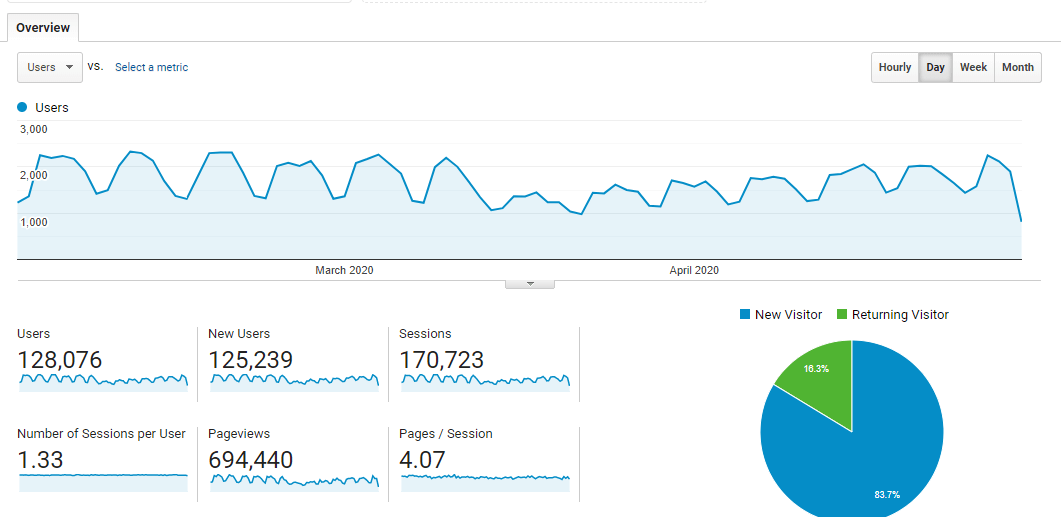
This is only a sample of the analysis available with Google Analytics, covering from the planning stages to the implementation of SEO.
But you find much more data in the tool to help with your strategy. Take control of your data with our Google Analytics guide.
Google Search Console
Google Search Console is a tool to facilitate communication between the site and Google, which offers valuable SEO reporting. Some of the resources include:
- Discover if there are any issues on indexing your site.
- Know if your site has been hacked or penalized by Google.
- Monitor the average position of your pages on SERPs.
- Identify the organic click-through-rate of your pages on SERPs.
- Identify which keywords place your site on SERPs.
- Identify which sites backlink to yours.
- Solicit rejection of dubious backlinks to your site from Google.
Google Search Console is a little more technical, with a greater focus on webmasters.
But the interface is user-friendly, so anyone can use it to diagnose and direct more complex demand to specialized professionals.
This tool can also generate insights to optimize your content, in addition to being the principal source for identifying which searches bring traffic to your pages and the click-through-rate on your main keywords.

How to do Keyword Research?
Keyword research aims to identify the search terms that have the greatest potential for your strategy, according to search volume, conversion, and competitiveness.
It’s one of the key planning tools for SEO strategy and Content Marketing. After all, it’s how you can identify optimization opportunities and set content creation priorities.
Keyword search usually starts with a list of terms related to your sector, product, and brand.
You can get ideas from Google Analytics and Google Search Console, which we previously discussed, or keyword tools, which we’ll learn more about below.
Afterward, this list needs to be organized. You can separate the most used terms at each stage of the sales funnel and sort the list based on the greatest potential for your strategy.
Let’s say you’ve just launched a blog on your site and have identified the keyword that will direct the most traffic to it.
You can start with it and create a post optimized for this keyword to attract more visitors.
Next, you’ll understand better what keywords are and what kind of terms you can work with.
What are keywords?
Keywords are how the users express their questions. They activate indexed pages in the search engine.
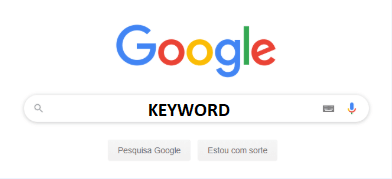
When a user searches for a specific term, Google looks for the best matches within its page index and displays these search results.
The order in which they appear is the result of ranking factors, as described above.
Therefore, keywords are essential in SEO strategies, as they reveal what our buyer persona is searching for.
They define the purpose behind optimizing a page, so Google indexes it correctly according to its content, presents it to the users seeking that topic, and ensures that the content is relevant.
It’s important to know that Google employs artificial intelligence to understand the intention of a search, the way humans communicate, and the variations that exist for a given term.
This means that if you want to optimize a blog entry for “carry-on luggage”, for example, you don’t need to worry about using this exact phrase in your text, much less repeat it endlessly.
You can use synonyms, such as “cabin baggage” or “hand luggage”, resulting in a more varied and engaging text.
So, even if the user types the term incorrectly or a variation of it, Google will understand the user’s search intention and display your page to them.
Thus, you don’t need to worry about a keyword’s exact match.
Types of Searches
During the purchase process, people may use different types of searches to resolve their questions.
To create your SEO and content strategies, you need to understand the intention behind each search to align what users are looking for with what your brand can bring them.
Let’s take a look at the main types of searches.
Navigational
Navigational search queries are when a user already knows which site they’re looking for and will rarely change their ultimate destination.
It’s as if they use Google as a shortcut, instead of remembering a whole URL or to find suggestions related to that site.
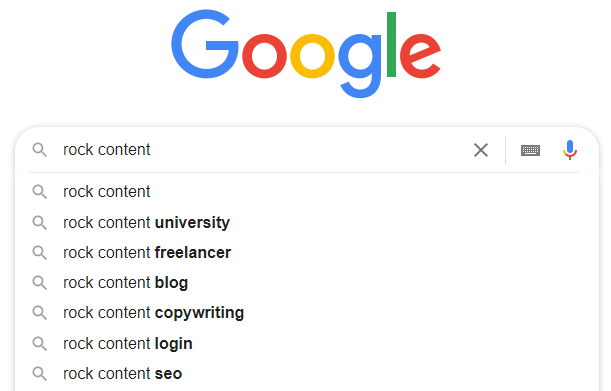
Transactional
Transactional search queries are related to purchases. For example, users may be looking to buy a product, find a store’s address, or compare prices.
This type of search is valuable because it can lead directly to a sale, as the user is already at a more advanced stage of the process.
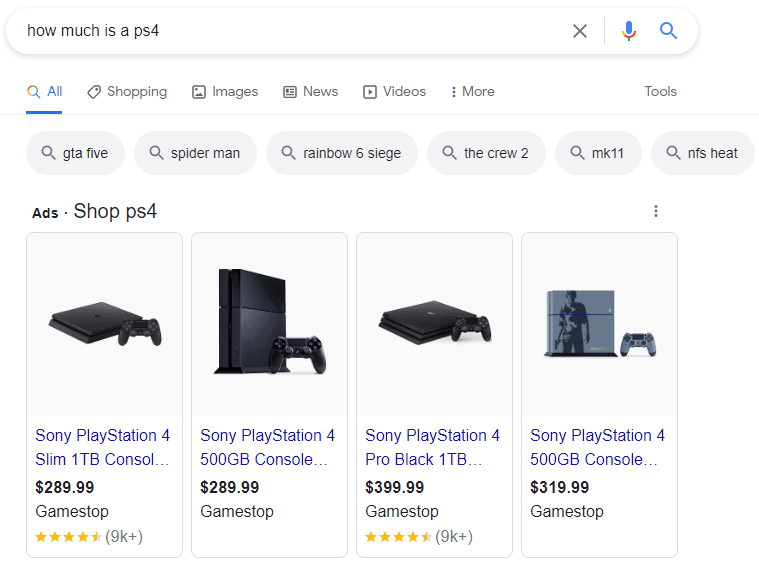
Informational
Informational search queries are when users are looking for information on a subject, product, or brand.
At this point, they don’t know what they want yet, as they’re at the start of the purchase process.
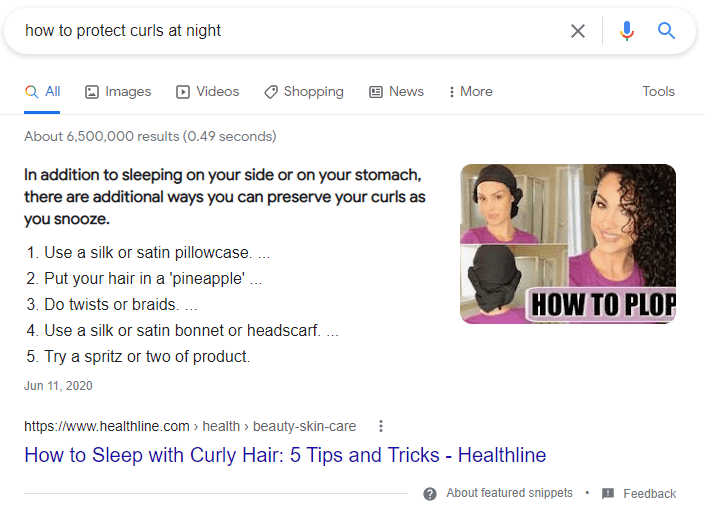
Local
Local search queries feature a geographic component, within a determined region.
These can include, for example, users searching for restaurants, cinemas, stores, hotels, schools, or offices, among other establishments with a physical location.
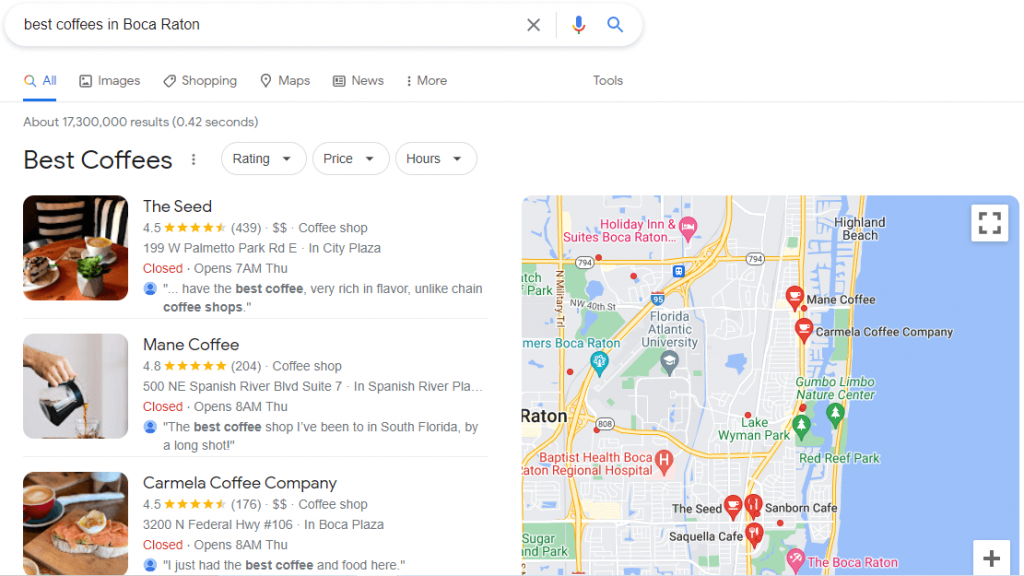
Other types of search
There are additional types of search a user may perform, such as:
- News
- Institutional
- Music
- Academic
- Punctual information (weather, date, etc.)
- Images
- Videos
Notice that, for each type of search, Google is constantly seeking to provide more specific results.
For product searches (transactional), you receive offers from Google Shopping. When looking for a certain song, results include the lyrics and a music video on YouTube.
The goal is to improve the search experience with more agile and precise results for users.
Types of Keywords
Along with types of search, we also need to consider the types of keywords that are used to find results on the web.
There are two types of keywords: head tail and long tail.
They refer to the two extremes you can see in the image below and correspond to different stages of the process.
The farther to the right the keyword lies, the more specific it is from a user closer to the purchase decision.
For an SEO strategy, it’s important to work with both types of keywords to reach potential clients at all stages of the process.

We will now look at each type.
Head Tail
Head tail keywords are broad, generic, and generally used at the start of the purchase process.
At this moment, the consumer doesn’t know what they need yet, and thus start with this type of search, before becoming more specific.
Generally, head-tail terms are high volume, resulting in a lot of traffic, but also attract a very wide audience with few conversion opportunities.
They also tend to face a lot of competition for the top search positions, making a high ranking more difficult.
In this case, examples include:
- Marketing
- Personal marketing
- Digital Marketing
- Business marketing
- Traditional marketing
Long Tail
Long-tail keywords are more specific and are usually used at the end of the process.
The customer has already researched what they need to meet their needs, is familiar with the solutions on offer, but still seeks information before making the final decision.
In contrast to the head-tail, long-tail keywords don’t usually generate as much traffic as they are less searched for.
On the other hand, they tend to attract visitors further along in the purchase process, as well as more conversions.
In addition, as a result of less competition, a higher ranking is easier to achieve.
If a user is interested in Digital Marketing, for example, they may now search for more specific terms on the topic. The specificity of terms will depend on the need the person needs to resolve, for example:
- Digital Marketing consultancy prices
- Where to take a Digital Marketing course
- The average salary for Digital Marketing professionals
Keyword Tools
Are you looking for help to find terms and identify the best opportunities? This is where keyword tools come in.
They are essential for planning an SEO strategy, as they help to find ideas for keywords, understand the potential and competitiveness of each, and organize them according to their optimization priority.
There are several tools for this, both paid and free.
Free tools help to perform specific search actions, including:
- Google Ads keyword planner: to check search volume and cost per click.
- Keyword Tool and Ubersuggest: to create lists of keyword ideas.
- Google Search Console: to check which words are already used to direct traffic to sites and opportunities.
- Google Trends: to determine search trends by theme.
Google Ads keywords planner is shown in the image below:
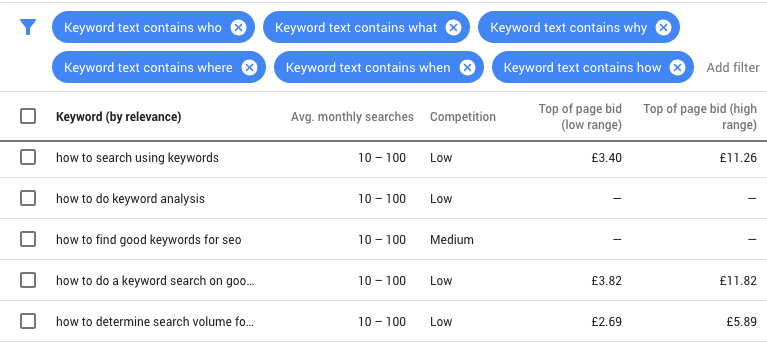
Paid tools are complete, with powerful keyword search features.
They suggest terms based on volume, clicks, difficulty to rank, and other data. The main platforms are:
- SEMrush (starting at US$99.95/month).
- Ahrefs (starting at US$99/month).
- Moz Keyword Explorer (starting at US$ 99/month).
Here’s an example of a keyword search on SEMrush:
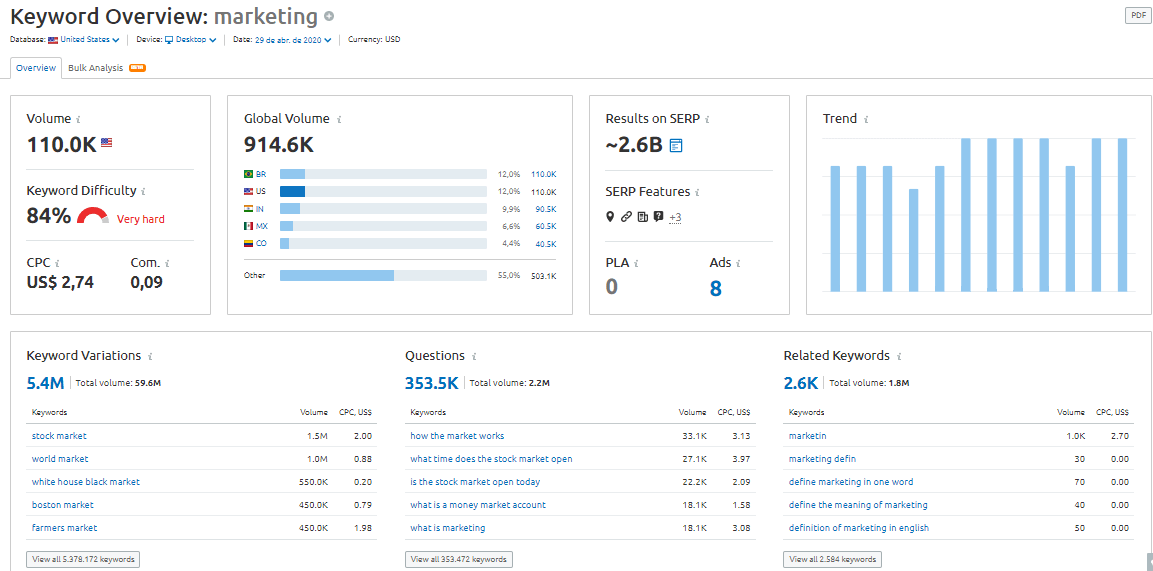
You can access some of the resources for free, but a paid plan allows you to take full advantage of the platform.
What is On-page SEO?
In this section, we will explore the key optimization factors for an on-page SEO strategy.
It’s worth remembering that “on-page” refers to the factors that an administrator can optimize on their own pages to improve a visitor’s experience and make it easier for Google to read the site.
These optimizations should be integrated within an overall Content Marketing strategy since they largely make use of what’s published on the blog.
Get a sense of the key on-page SEO factors.
User Intent
SEO is not about what people are searching, but what they want to find.
To do this, on-page optimization should focus on the user’s search intention, which varies from search to search, so your pages and content correspond to what they hope to find.
This is where Google’s focus on giving users what they’re looking for comes into play. For example, natural language processing and analyzing user location are elements that help determine their intention.
So, the challenge for an on-page SEO and Content Market strategy is understanding the search intention the way Google does, to deliver to users what they’re looking for.
And the best way to understand a user’s intention is by using Google itself!
Let’s take a closer look at some example.
Following your keyword search, you should use Google to analyze the highest-ranking results. After all, these are the pages that Google considers the best answer to the user’s intention.
Let’s examine the results page when we search for “SEO”:
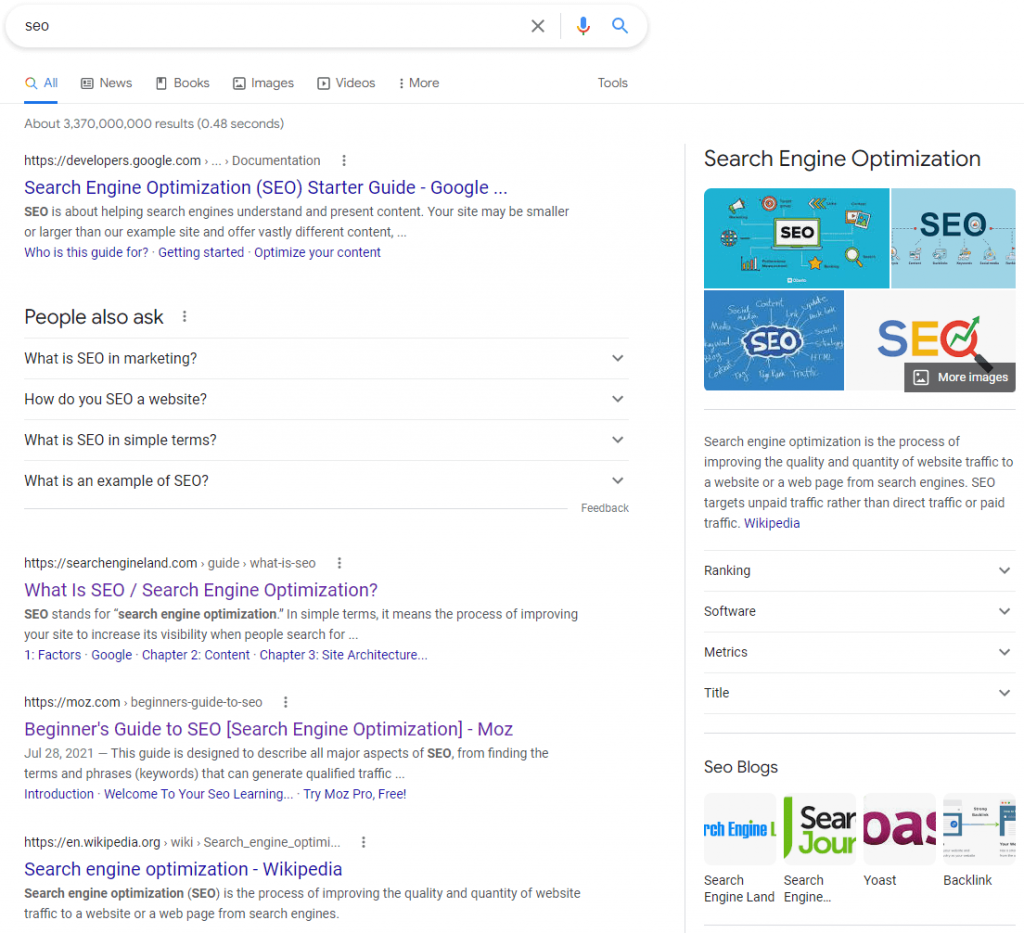
Note that the top results are educational, with a focus on teaching what SEO is and how to use it. To rank higher, you need to have content along these lines.
But what if my intention were to find a “Batman costume”? What am I trying to find?
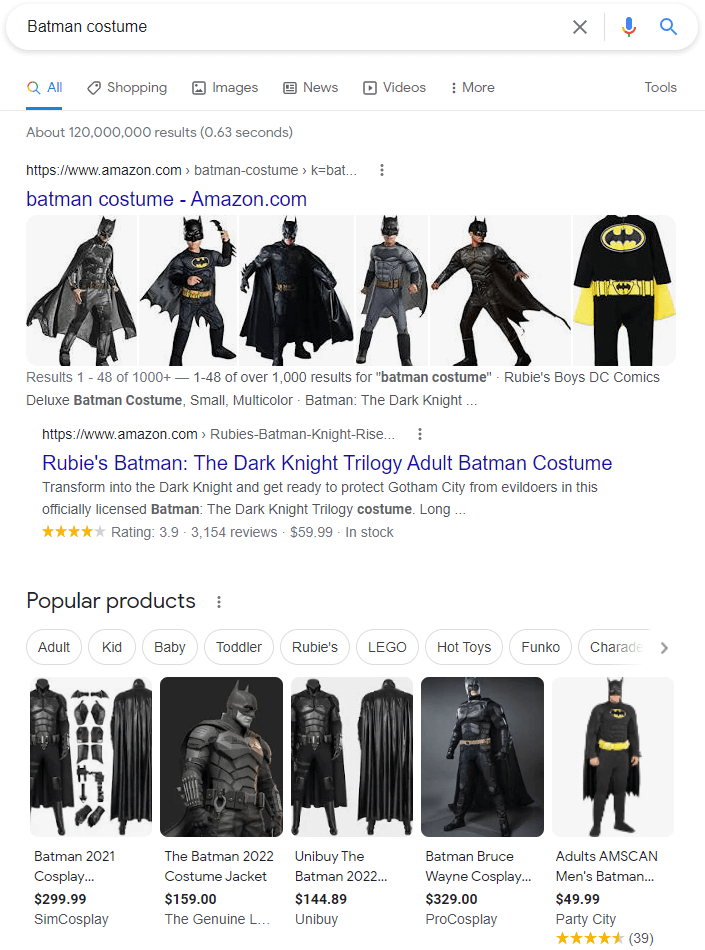
Pictures, exactly! Products and images. Can you imagine someone renting or buying a costume without seeing it first?
So, to reach the top of this result, you must use images.
Always use the first results for a specific keyword to identify how you should approach the subject and what else you can add to it.
Get ahead of them with content that’s even more optimized and complete!
Content length
The length of content generally affects its ranking, but it’s not a direct ranking factor in the algorithm.
Longer pieces tend to be complete, have more details, and go deeper into the subject matter. As a result, they better answer users’ questions.
But this isn’t necessarily a rule. For a given topic or buyer persona, the ideal length will be different.
Here at Rock, for example, we post super in-depth content, like this article.
It’s a broad search term, facing a lot of competition and receiving a high volume of searches, which demands extremely thorough content as a result.
On the other hand, a blog post about blocked actions on Instagram is far more specific, with fewer hits and competitors, so it can be shorter and more direct.
Accordingly, the best length is the one that best answers the user’s question.
Volume of posts
Publishing quantity also tends to favor classification, as the more content you publish, the greater chance you have to rank high.
However, you can’t just focus on the number of posts, ok?
Make sure you have a balance between quality and frequency.
There’s no point in publishing hundreds of pieces that aren’t relevant and don’t solve users’ questions — in fact, it’s counterproductive.
Likewise, having a large number of posts when you launch your blog, and then not keeping it updated brings no advantages.
Content creation needs to be an ongoing process in order to attract a loyal audience and show Google that what you have to offer is fresh and relevant.
Along the same lines as the volume of posts, there’s not an ideal frequency. You have to identify what your topic and buyer persona demand, as well as evaluate your business’s ability to produce this content.
The most important thing to remember is that quantity and quality work together.
Writing for SEO
How do you need to approach writing your content?
Quality is the number one priority. The content needs to be accurate, clear, current, relevant, trustworthy, and, of course, address the user’s intention.
This will generate engagement and increase the likelihood of receiving backlinks — weighty factors in the ranking calculation.
So even though Google increasingly understands and values natural writing, there are some strategies to optimize your content to reach higher positions, while also improving the reader’s experience.
To achieve this, it’s crucial to pay attention to an article’s scannability and semantics.
Scannability
Scannability is how a text presents a dynamic reading by making use of resources such as subtitles, lists, bold, and images.
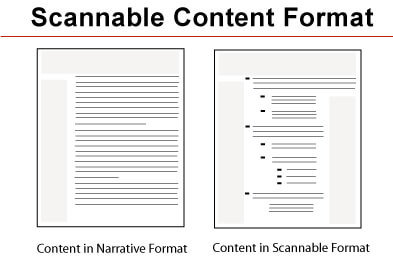
Have you ever opened an article, been faced with a solid block of text, completely lost your desire to read that content, and simply closed the page?
This is what makes scanability so important.
It improves the reading experience, engages the user, and even communicates information to Google.
By creating subtitles, for example, both readers and bots are able to understand the structure of the piece.
Keyword use and semantics
The use of keywords throughout your writing is important for Google to index the page with the terms you want correctly.
Keep in mind that this doesn’t mean just repeating one word the whole time, ok?
Google understands how humans use language and aren’t looking for exact keyword matches.
This is what makes semantics so important for SEO.
Take full advantage of a term’s semantic field, its variations, synonyms, and relationship with other words. By doing so, it becomes easier to read and helps Google to understand the topic of your page.
Let’s compare two pieces that have the objective to reach the first results for “Digital Marketing”:
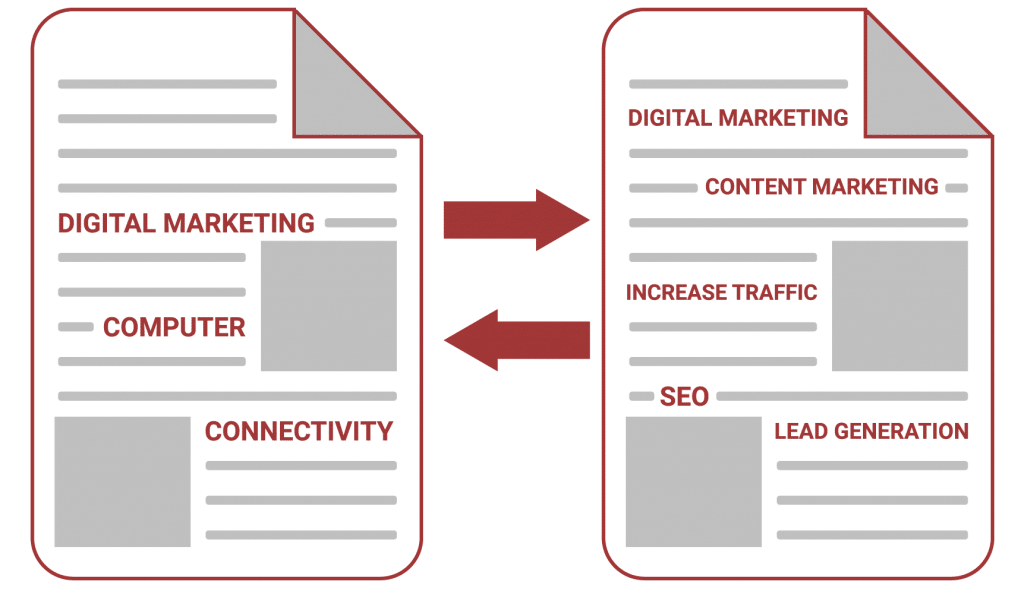
The content on the right has a better chance of a high ranking, as it covers indispensable topics directly related to producing a Digital Marketing guide.
Here’s another example focused on “SEO”:
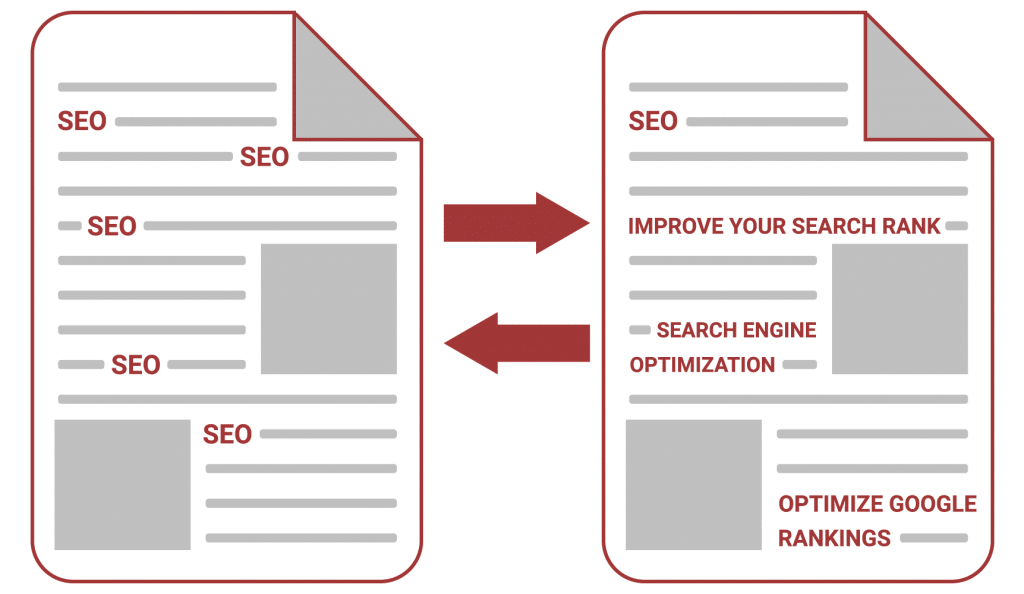
Again, the piece on the right displays better optimization, with several natural variations of the term, improving the reading experience for users and bots and increasing its chances of a higher position.
Furthermore, it’s important to place these terms where Google will value them the most.
The title, heading tags, URL, and the first paragraph are some examples of where bots tend to focus first.
So make sure to place keywords in these locations.
Title tag
The title of the page that you see on the SERP, in browser tabs, and when you share links on social networks is the Title Tag.

Title tags are fundamental for Googlebot to grasp the key theme of the page, and also for users.
After all, the title is the first contact a reader has with the text and can affect whether they click through to read it or not. With this direct influence on your click-through-rate, this tag is one of the most important on-page factors.
Therefore, as part of your SEO strategy, this tag should feature your keyword, but also incentivize your user to access your page.
Meta description
Meta descriptions are the description of a page that appears in search engine results, a snippet of the page with the title and URL.

They also serve as a way to encourage users to access the page, so they should be persuasive and descriptive about what is offered.
Note that meta descriptions are not a direct ranking factor, meaning Google doesn’t consider them in its algorithm.
But it’s still important to ensure your keyword shows up in it, as it will appear in bold if it coincides with what the user searched for.
Meta descriptions attract more clicks, indirectly influencing your results.
Heading Tags
Heading tags are code markup, which identifies titles and subtitles in the text.
The H1 tag identifies the title on the page, yet differs from the Title Tag.
If the goal of the Title Tag is to get users to click through, H1 aims to get users to read the text. It also doesn’t have the character limit of a Title Tag.
Take a look at this example:


There is a structured order to heading tags, with H2, H3, and so on.
These heading tags identify subtitles and show the structure of your text, useful both for Google and for your user.
Using these increases scanability.
It’s important to use keywords, and semantically-related terms within these tags since Google analyzes subtitles for its indexing and ranking.
URLs for SEO
URLs are also targets for Googlebot.
Page URLs are crawled to get a sense of their central focus since they generally use terms that summarize their content.
They need to be clear to users and readers. Check out this table we made with some of the most common URL mistakes:

A descriptive URL is much easier to understand — not only for bots but also for users.
- Avoid meaningless URLs: URLs consisting of random characters or gibberish don’t help with SEO. An SEO-friendly URL includes keywords and mirrors the page title instead.
- Avoid numbers in URLs: Numbers can easily change during content refreshes, which means that the URLs will also need to change. This can lead to broken links, redirect problems, etc.
- Avoid big URLs: Shorter URLs are simpler and more accessible, both to human readers and Google’s crawl bots.
- Avoid invalid characters: Including invalid characters (like capital letters, symbols, or spaces) in your URL can render your entire URL invalid.
- Be careful with subdirectories: Too many subdirectories can overcomplicate your URLs and potentially cause sitewide issues.
Here are some good practices:
- Easy to interpret
- Short and friendly
- Contain the keyword
- Match the title
- Avoid articles, linking verbs, and other complements
Some examples of good URLs:
- “sitename/blog/digital-marketing/“
- ” sitename/storytelling/”
- ” sitename/courses”
Images for SEO
Google still can’t completely understand the content of an image and needs your help to understand what it represents. What can you do?
Use image optimization for SEO.
This strategy allows you to provide textual data about the images. This can include alternative text (alt tag), filenames, image captions, image URLs, and context (the text around the image).
The important component here is the alt text, which is fundamental to the experience for individuals with visual impairments, as a screen reader reads the alternative text to describe the image to the user.
The alt text should always be a description of the image and contain the keyword.
Consider this example:
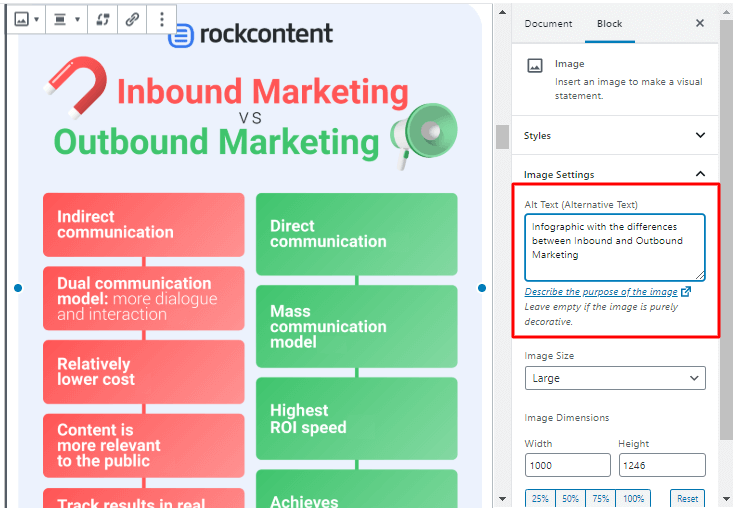
Through these elements, Google can understand what is in the image, index it correctly in Google Image Search, and it becomes another source of traffic.
Other aspects concerning image optimization for SEO include the size and format of image files so that they can be quickly loaded and indexed.
Internal links
The network of your site’s internal links also plays a role in on-page SEO.
The primary function of links between internal pages is to guide navigation and lead the user (and search engines) to other relevant content.
But they also have a technical SEO function. The network of internal links helps Google to find your content and better understand your site, as it reveals the hierarchy between pages.
For example, the closer to the homepage and the more internal links, the more important the page.
This link building strategy strengthens the authority of the blog through the links and this is how a topic cluster strategy works.
Rich Snippets
Rich snippets are content fragments from the page which provide additional information on the SERP. These can include site links, reviews, the number of comments, product prices, and more.
For example, here is the information provided through rich snippets when searching for “red velvet cupcake recipe”:

In this case, rich snippets provide us with a picture of the recipe, a review, comments, and even how long it will take to make.
Different from the usual results, right?
Rich snippets offer extra information about your pages to bots and users and highlight your link on SERPs, which tends to increase your click-through-rate (CTR).
To display rich snippets, they need to be created with structured data, as organized content is easier for the Googlebot to read.
This can be accomplished by programmers or even by using plugins, useful for WordPress sites.
Two sites can help you implement rich snippets.
The first is Google, which offers a list of rich snippets where you can identify the type you want to use, and they show you the code to use.
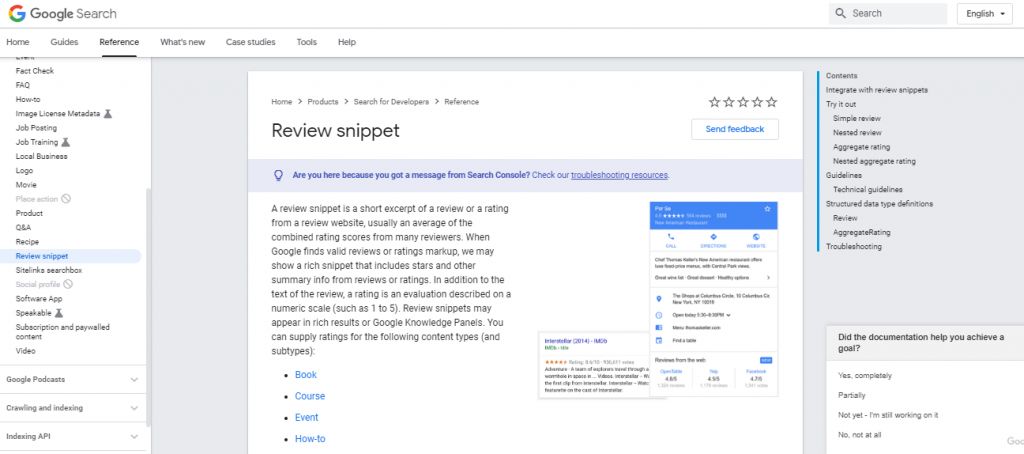
Access it at Google Developers.
The other site providing similar functionality is Schema.org. Here’s an example with a recipe snippet:
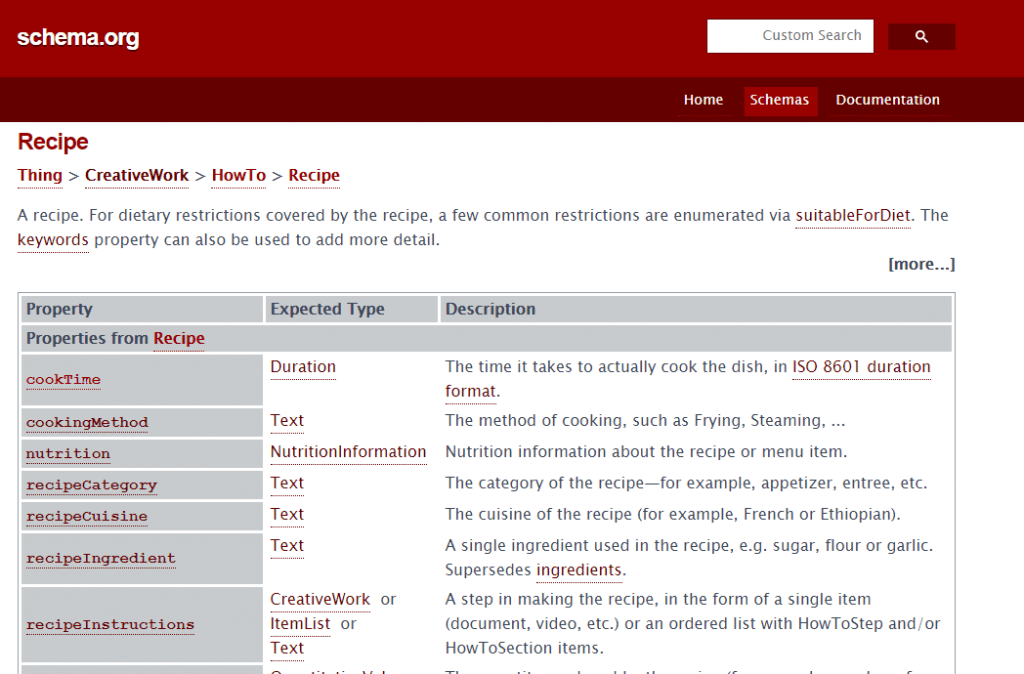
Featured Snippets
Have you noticed how Google provides ready answers on its SERP for some searches?
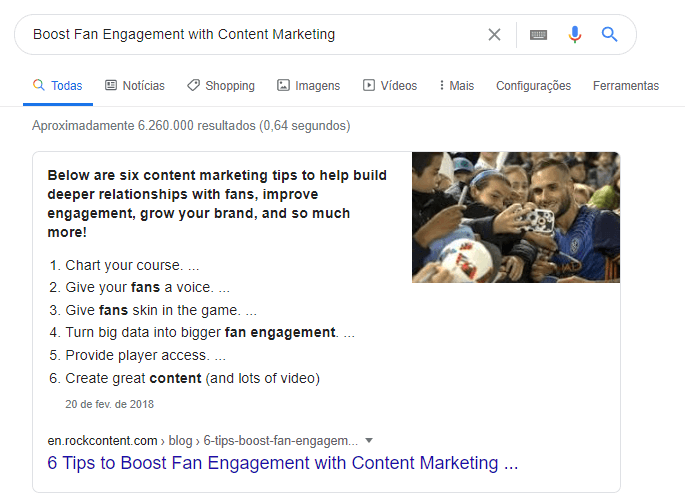
These are known as featured snippets and are excerpted highlights of pages that provide direct results in paragraphs, lists, or tables.
This is great for the user’s search experience! After all, they get the answer they’re looking for even faster.
But if fewer visitors reach your pages, what’s the impact on your traffic and results?
Keep calm. Featured snippets are a great opportunity to increase your authority on a specific topic and can lead to more traffic from the SERP, as the excerpts include a link to where they came from.
On-page SEO strategies need to be competitive to reach this “zero result” on Google.
EAT
This acronym has become the focus of SEO experts. EAT stands for Expertise, Authoritativeness, and Trustworthiness.
Google adopted these terms to orient its assessment of search result quality.
They were introduced in the documentation that guides the evaluators who manually analyze the relevance of search engine results.
They reveal what Google considers important when evaluating the quality of content.
- The expertise of the author.
- The authority of the author, the content and the site.
- The trustworthiness of the author, the content, and the site.
As a result, you can follow these guidelines in your content and SEO strategy to align with Google’s way of thinking.
What is Off-page SEO?
Now, it’s time to examine the factors beyond your pages with off-page SEO. What steps can you take to have more authority in the market and show Google that you are a reference?
Here you need to consider that, unlike on-page SEO, with off-page SEO you don’t have complete control over the optimization.
The choice to include backlinks to your site, mention or directly search for your brand depends on others.
What you can do is increase your chances of this happening. You can adopt link building, guest posting, redirects for broken links, in addition to other strategies to reinforce your backlink profile and create greater authority for your page.
Next, let’s learn some more about each of these strategies.
Link Building
Links are the building blocks of the internet. They connect one page to another and allow users to navigate and discover content.
Just like users, bots also travel this interconnected network to index new content and understand which pages are the most important, as one page transmits link juice and authority to another.
Here we can see why link building is so important to off-page SEO.
Link building is the construction of a network of links that point to your pages (known as backlinks) and strengthens your authority on the web.
Google’s algorithm understands that the more high-quality backlinks your page receives, the greater its relevance to the market.
But keep in mind that quantity and quality work together. There’s no benefit in receiving hundreds of backlinks if they all come from a single domain, or untrustworthy site, or are placed out of context.
To get a link-building strategy to work, achieving high-quality backlinks is a must.
High-quality backlinks
As we’ve seen, Google acts to prevent actions that correspond to Black Hat.
Link building was previously used extensively to generate artificial authority, with schemes from link farms to the “super optimization” of anchor texts.
High-quality backlinks run contrary to these tactics and demonstrate that the links you have received are on merit and are relevant to trustworthy references in your sector.
High-quality backlinks:
- Are from sites with domain and page authority.
- Are from sites that Google trusts.
- Come from a variety of domains.
- Are natural in the context of the page.
- Use anchor text correctly.
- Are in a prominent position on the page (at the start of the piece, for example).
- Are from sites connected to your sector.
These are the main characteristics you should look for in backlinks when planning a link building strategy.
Nofollow Links
Another important point about backlinks: the difference between dofollow and nofollow links.
By default, all links are “dofollow”. This attribute tells bots that they should crawl the link and share authority from one page to the next.
In contrast, the “nofollow” attribute prevents the bot from following the link and passing authority to the linked page.
This can come in handy, for example, in comment sections or for links shared on social networks, which are frequently used for spam for building artificial authority.
But this doesn’t mean that nofollow links have no role to play in off-page SEO.
Even though they don’t spread authority directly to other pages, they generate traffic and develop brand awareness.
Link-Building Techniques
Let’s take a look at which link-building techniques you can employ to strengthen your authority.
Here are a few key ones!
Link Bait
Link bait is the most natural and efficient strategy.
It involves creating high-quality content that receives backlinks organically without requiring prospecting or partnerships.
To accomplish this, you should invest in creating rich content, share data from exclusive research, and provide tools and resources as well as other forms of content that are worthwhile assets to link or share.
Guest posts
Guest posting involves publishing posts on partner blogs as guest author.
It usually takes the form of trade: you create content for the other blog’s audience in exchange for one or more links to your site.
If the links employed are “dofollow”, this can attract new visitors and lead to greater authority.
But it’s important to engage this strategy in moderation. If Google sees you receiving a large number of backlinks in a short period of time, it may understand this as a black-hat technique and punish your pages.
Brand mentions
Brand mentions, even without linking to your site, are also valuable to SEO. Google analyzes these to recognize if your brand really exists and how well-known it is.
You can also search for any unlinked mentions and identify opportunities to receive high-quality backlinks.
Simply get in touch with the administrator and politely suggest including a link.
Broken links
What happens when a site’s URL structure changes or content is removed? This can result in broken links across the site.
If you’ve ever clicked on a link and been brought to a 404 Error page, you’ve witnessed firsthand how broken links can result in lost opportunities and communicate less authority.
But if you come across links on sites with related content to your own, it’s a chance to recommend replacing those broken links with ones to your content.
Several tools exist to uncover broken links, such as Screaming Frog, Ahrefs, or Check My Links:
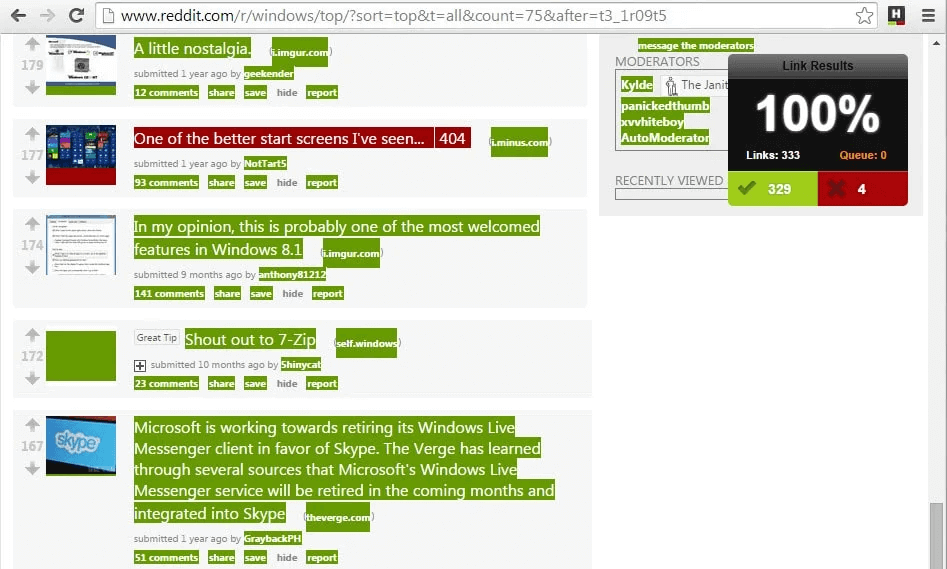
Link building tools
There are a variety of link-building tools available, both free and paid, or with a focus on specific actions or specializations.
Tools including Majestic, Ahrefs, Moz Link Explorer, and SEMrush offer a complete analysis of a page’s backlinks profile, from the number of connections to the quality of the anchor text.
Some offer proprietary indicators to aid in this analysis, such as Majestic’s Trust Flow and Citation Flow or Domain Authority and Page Authority from Moz.
These tools are paid options but offer some resources for free.
Furthermore, you can work with more specific tools to focus on determining outcomes.
Examples include using Google Search Console to request Google reject backlinks from untrustworthy sites or Google Alert to notify you whenever your brand is mentioned to identify backlink opportunities.

How Does Technical SEO Work?
SEO is a vast universe that includes more technical aspects related to your site’s structure. Let’s take a look at these factors and how to optimize them!
Technical SEO is a key part of on-page SEO. It includes all of the optimizations you can make to the internal structure of a site — the code and underlying architecture — in an effort to make it faster and easier to understand, crawl, and index.
In the next topics, we’ve brought the main elements technical SEO can optimize.
Sitemap
A sitemap is a document that lays out the relationship between all of the pages on a site and information about them, such as when they were most recently updated or how often changes are made.
Its function within SEO is to provide this information to search engines to make it easier to find and index the URLs.
Although search engines already get this information through their bots, sitemaps simplify the process and ensure all pages get indexed.

You can either create a sitemap manually or through tools and plugins, then submit it via Google Search Console.
Robots.txt
Robots.txt is an additional document located in your site’s root folder, which lets Google know which pages on your site should be ignored and not appear in search results.
You can use robots.txt to prevent bots from accessing sensitive data, such as your admin login page (“/wp-admin/” on WordPress sites, for example), or scripts and stylesheets that aren’t important.
It’s important to remember robots.txt if your pages aren’t appearing in search engine results, as they may have been added to the list by accident.
UX (User Experience)
User Experience and SEO are two approaches that support each other. We’ve seen here that the priority for search engines is to offer the best search and navigation experience to users looking for something.
And this includes the experience on your site.
But what does user experience involve? It covers how sites are developed to focus on the actions and responses of users to address their needs.
According to Peter Morville, president of Semantic Studios, there are seven essential characteristics of good UX.
- Useful
- Usable
- Desirable
- Findable
- Accessible
- Valuable
- Credible
Page speed
How long a page takes to load is one of the main classification factors.
Google itself openly discussed that speed is a key ranking factor — for desktop search in 2010, and mobile search in 2018.
It should be mentioned that speed alone won’t get you to the top of the results, but you won’t get there without it.
A fast page speed won’t lift you above the competition, but a slow one will lower your ranking.
For Google, the quality of a user’s search experience depends on the agility of information, as people have become used to not having to wait for what they want to find.
This led to Google offering a free testing tool: PageSpeed Insights.
It provides a speed diagnosis report with tips on how to improve the load time through image and code optimizations.
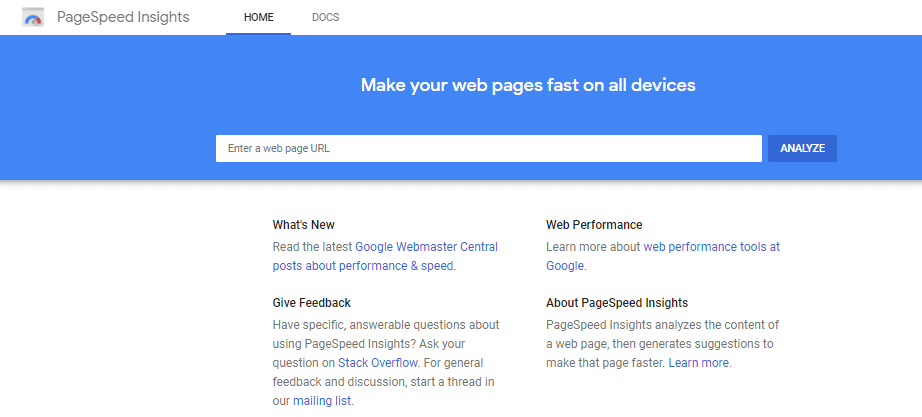
Mobile-First Index
Since cell phones are more common than computers, mobile search has overtaken desktop search.
With more traffic from mobile devices, Google began to prioritize results from sites that offer a strong mobile experience.
In 2015, Google announced that mobile-friendly had become a ranking factor for search on mobile devices, which resulted in many sites adopting responsive layouts.
A similar impact was brought about with the launch of the Mobile-First Index in 2016, which considered mobile versions of pages first when ranking.
So if you haven’t yet adopted these trends, it’s important to focus on improving usability and the experience of your content on users’ mobile devices.
Responsiveness
Implementing a responsive site design is one of the strongest recommendations for making your site mobile-friendly.
This technique allows your site to have one single version, which can then adapt to different screen sizes.
Besides a responsive layout, there are two other techniques you could consider adopting.
- Mobile URLs, with a different URL than the desktop version (for example, m.domain.com).
- Dynamic Serving, where the two versions have the same URL but use alternate CSS and HTML depending on the device.
To get a better understanding of how your site performs on mobile, you can check through Google’s mobile device compatibility test to get recommendations on optimizations you can make.
AMPs
Accelerated Mobile Pages is a further initiative to improve the mobile search experience.
It’s an open-source code project initially led by Google, which aims to develop static content pages that load faster on mobile devices.
These can be identified on mobile SERPs by the small lightning bolt icon next to the URL — and are given preference in the ranking. Take a look at the following example:

SEO Audits
An SEO audit is an important step to make sure you take as part of your technical SEO strategy, especially at the start of your optimization project.
It can be used to identify problems involving page speed, usability (especially more mobile), crawling, and other errors that affect users’ navigation and site ranking.
Here are a few of the elements that an audit can diagnose:
- Broken links
- Crawling errors
- Redirect errors
- Duplicate content
- Blocked pages (robots.txt, no-index, nofollow)
- Pages that are loading slowly
Screaming Frog is one of the best tools to solve these issues, offering in-depth reports on the topic listed above.
But an audit can also involve other tools, including SEMrush and Google Search Console.
What is Local SEO?
One of Google’s priorities in recent years has been understanding the intent behind local marketing.
Search engines understand that searches made at certain locations require contextual results, offering practical and objective information as opposed to the list of links traditional SERPs provide.
For these searches, Google created local search algorithms to prioritize results in the region the user is located or included in the search.
Similar to featured snippets, the search engine offers information from Google My Business directly in the search results in such a way that users don’t need to access the brand’s site.
Based on this, optimization for businesses with a physical location — known as local SEO — has a few specific details that require attention.
What does this mean for your optimization strategy? Find out below!
Local keywords
To display local results, Google attempts to understand the user’s local search intention.
In the case of searches for “pizzerias”, “pizza near me” or similar terms, Google takes into consideration the user’s location when the search was made and offers businesses in the area.
But if the user searches for “Boca Raton pizza”, the SERP will display results for the region in the search, regardless of the user’s location.
This is useful for individuals planning trips, for example.
So keyword research for a local SEO strategy should consider these variations of search intention, not simply those with your city.
Consider the following cases:
- Terms that identify a sector: e.g., pizzeria, pizza, neapolitan pizzeria
- Modifier terms: e.g., best pizza, cheap pizza
- Geographic modifiers: e.g., pizza in Boca Raton, pizzeria downtown, pizza near me
Google My Business
Google My Business is the main ranking factor for local SEO.
At the top of a local search SERP, Google displays the Local Pack, a box with three specific results for the user, based on information taken from Google My Business. And you should fight to make sure you show up there!
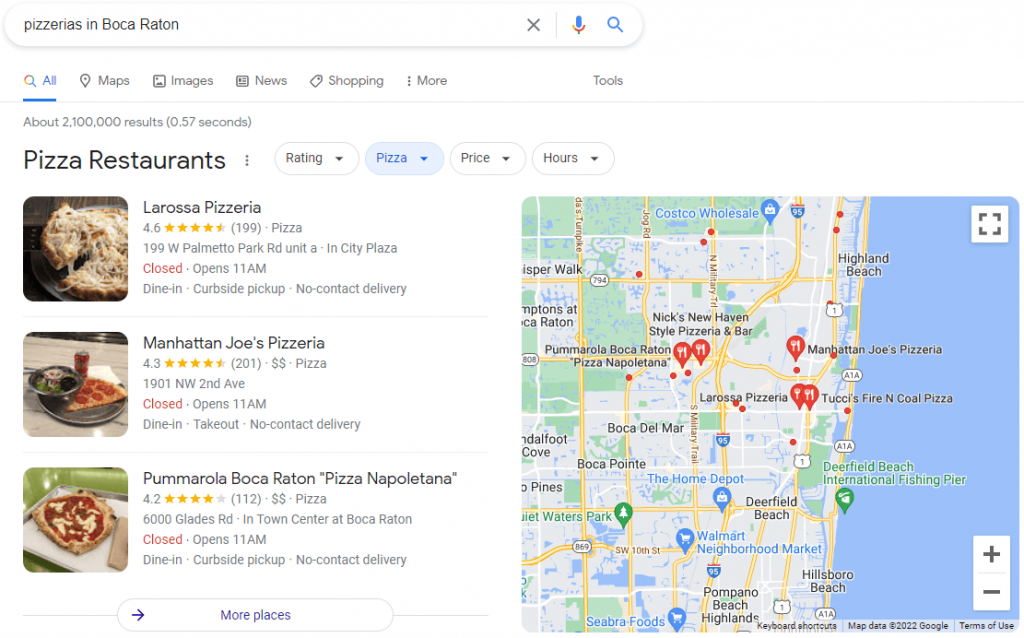
For your content to make it to the Local Pack, you need to register your company on Google My Business. This tool offers several resources for participating in local businesses.
You can submit your business name, address, phone number, and business hours. Then, you can receive ratings, answer users, upload photos, list your menu, and other specific details according to your business type.
Take advantage of the opportunities offered by registering and engaging your users to improve your chances of showing up in the Local Pack.
Google gives preference to businesses that have provided the most information, especially those with a high number of strong reviews.
Ranking factors
Google uses three key ranking factors for local search: relevance, proximity, and prominence.
The search engine reveals these criteria on its page, outlining recommendations for local ranking.
A combination of these factors is analyzed to provide the best results. For example, if a company is farther away from the user, but provides delivery, it may rank higher.
Let’s examine each of these factors in detail.
Relevance
Relevance includes the relationship between the search keyword and the product or service offered.
When searching for pizzas, the user doesn’t want to see Japanese restaurants, right?
This is why it’s so important to complete your Google My Business registration with all possible information since that’s how Google is able to make these connections.
If a user searches for “all-you-can-eat pizza”, Google will only return locations with that option.
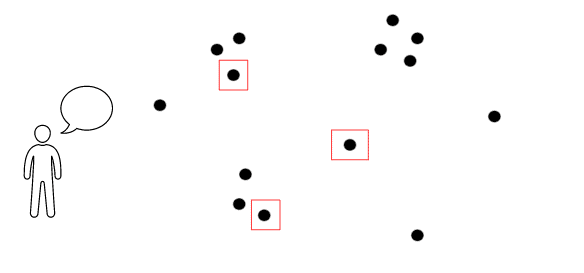
Proximity
Proximity refers to how far a business is from the user’s location or the location included in the search.
Google considers the closest results as better.

Prominence
Prominence assesses how popular the business is in a given region, based on online and offline factors.
If the business’s online presence isn’t so strong, but it’s a well-known and trusted brand offline, it can still achieve a good ranking
But it also strongly considers ratings and positive reviews from Google My Business users, plus the traditional on-page and off-page SEO used by the site.
The more trust Google gives to your business based on these elements, the higher your local ranking.
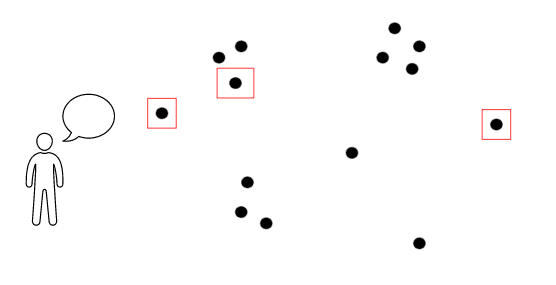
International SEO
Dreaming about what it would be like to take your company global is one thing, but mastering what it takes to actually do so is another. Your understanding of the best international SEO practices will make a big difference in how successful you ultimately are, as they’re different from the standard SEO tactics that you may have used.
But what is SEO with international reach all about, and how can you get started? Here are some tips to consider.
Understand the basics
When a search engine user performs a search, Google tailors the results according to various criteria, including language and location. Integrating international SEO into your approach involves signaling to search engines that your site is accessible to users from foreign countries or who speak different languages.
Do your homework
Social trends, tastes, and expectations can vary drastically from one country to another, so do plenty of research. This includes international keyword research and domain structure research.
Apply what you know
Before your website’s international launch, it’s crucial to check and double-check all of your content to ensure that it meets the highest standards. Among other things, you’ll need to verify the accuracy of translations and any charts.
Going global with your SEO efforts is a big decision, and it’s unlikely that you’ll be able to handle the entire job on your own. Consider outsourcing to an outside agency or assembling a team of freelancers who can help.
The Importance of Content in SEO
There’s definitely nothing wrong with paid advertising when it comes to your ongoing SEO campaign. However, it should be considered a companion strategy to hands-on approaches meant to boost organic search visibility, not a replacement.
Content is the heartbeat of any organic SEO strategy, so investing in your ongoing content marketing campaign is a vital part of your eventual success. Here’s a closer look at why it’s so important.
It makes your brand visible
As you already know, SEO is all about helping your site achieve higher search rankings, and with good reason. Over 28 percent of Google users click on the very first SERP result after performing a search. And an additional 15 percent and 11 percent click on the second and third results, respectively.
So, the higher you can get your landing pages to rank on Google, the more visible you will ultimately be. And the more visible you become, the more traffic you’ll get, and the higher your rankings will continue to rise. But without high-quality content in SEO, visibility simply isn’t possible.
It improves user experience
Overall user experience is another critical factor that directly affects your site’s SEO cred and ability to get Google to see you as a key authority on your topic of choice. But today’s version of Google is nearly as smart and intuitive as your human visitors are, so it’s not enough to sprinkle a few keywords here and there throughout your site before calling it a day.
Your site needs to treat visitors to a truly enjoyable, positive user experience, and how you handle your content is a big part of that. Google likes what your visitors like – helpful, well-written, readable content that successfully expands on any included keywords.
It facilitates organic backlinking
There are many recognized signals that tell Google a site is doing something special and deserves to be seen as an authority, but backlinks are among the most important. And the best way to encourage lots and lots of high-quality organic backlinks is to take your content seriously and ensure it turns heads.
Keep in mind that another site or reader links back to the content they not only found helpful but feel completely comfortable recommending to their own readership. So focus on creating original content that your visitors will see this way.
You can also actively encourage backlinking by asking visitors, readers, and social media followers to share your content if they enjoy it. You can try actively reaching out to industry peers to suggest backlink exchanges in situations where it makes sense, as well.
It’s the most effective way to leverage keywords
There are many ways to incorporate keywords into your site structure and support effective SEO. For example, keywords are musts for your URLs, metadata, and title tags. But the most powerful way to use them to your advantage is also the most obvious – by skillfully using them within your actual site content.
When skillfully and naturally used in web content, keywords can work wonders for your SEO. They can also make sure you reach exactly the customers you want with each new piece. And, of course, the better you are at reaching a target audience, the better you’re going to look to Google.
It keeps your clickthrough rate high
When it comes to Google, achieving those high SERP rankings you’re after isn’t something you do once and then forget about. If you’re serious about maintaining (and eventually improving) those ranks, you need to make sure Google users are actually clicking through to your site when it’s served to them.
A high clickthrough rate (CTR) tells Google that your links deliver on user expectations. And if those users stay on your site for any length of time once you’ve got them there, that looks even better. CTRs like that are always accomplished via compelling, fresh, relevant content that accurately delivers the answers your visitors come to your site looking for.
All that said, it’s impossible to underestimate the importance of world-class content in SEO when it comes to making a massive success out of your website. Without it, it quite simply won’t happen.
Creating great content isn’t really enough on its own to put you at the top of the heap. The content in question must be truly exceptional, and you need a steady ongoing stream of it to meet your goals. WriterAccess connects you with world-class writers and content creators who can help you scale your content efforts affordably without sacrificing a thing when it comes to quality.
SEO Case Studies and Success Stories
So, what is SEO like when it’s working out well for a particular company or brand? Take a look at the following case studies and optimization success stories for a little inspiration.
Vimeo
Video giant Vimeo had a long list of the best SEO practices to incorporate into their strategy at the start of their SEO journey, including hard-to-scale tasks like sitemap submission and the addition of structured data. But in 2022, they rocked their goals and boosted user experience by implementing Google’s recommended practices.
ZipRecruiter
ZipRecruiter has always been famous for distributing job postings from companies and organizations of all sizes. However, they also adopted a structured data approach to their SEO strategy in 2012. When Google launched a job-focused search function based on structured data in 2017, ZipRecruiter reaped the benefits thanks to their preparedness.
Eventbrite
Event coordination brand Eventbrite increased its incoming traffic by 100 percent thanks to the smart use of structured data and other SEO-friendly best practices. After seeing an uptick in the number of events that showed up in Google Search, Eventbrite reinvested in its previous efforts to the tune of amazing results.
SEO Trends and Future Predictions
The internet, search engine algorithms and everything else involving SEO can evolve pretty quickly, especially these days. That’s why smart marketers strive to stay ahead of the game by keeping up with SEO trends. Some current emerging trends to watch include the following:
- Artificial intelligence is already impacting SEO in multiple ways and will continue to do so as tech evolves. You’ll see an increased number of tools and interfaces that leverage AI to merge content creation, SEO, and more.
- Voice search is another on-trend development that’s already huge but will become even more important in the future. Creating content with long-tail key phrases and natural language in mind can help give brands a valuable SEO edge.
- Machine learning tech means SEO tools and search interfaces are getting smarter, making content quality, accessibility, and authority even more important than they already are.
And, of course, some of the things that go into great SEO will continue to be as essential as they are now. Examples include writing for people instead of bots, ensuring sites are mobile-friendly, and prioritizing helpful authority content.
What Google Thinks of AI Content
In August of 2022, Google rolled out what’s now famously known as its helpful content update. This was part of the search giant’s ongoing effort to ensure its users see as much genuinely helpful, “people first” content as possible when they perform their searches. And content creators that focused on creating content in line with the update were rewarded.
Before the update rolled out, people speculated that AI-created content wouldn’t meet the criteria necessary to designate it as helpful content. However, that really didn’t happen. A subsequent spam elimination-focused update in October of 2022 did see some websites that relied exceptionally heavily on AI content slightly affected, but that’s about it.
So, does Google dislike or condemn AI-created content? Not on principle. But as with any other type of content, it’s essential to make sure any AI-enhanced material is held to the same high standard as everything else you put out there.
Bing and ChatGPT
It’s also worth noting that there are plans to launch an upcoming version of Bing that leverages the popular chatbot platform ChatGPT to enhance its search capabilities. The goal behind combining Bing and ChatGPT in this way is to help make Bing more competitive with Google.
Those interested should watch for this new version of Bing to hit the search engine scene in March. In the meantime, here are some considerations to keep in mind.
- At present, Bing holds about 9 percent of the search engine market share. However, if its new ChatGPT-enhanced incarnation is a success, that could change drastically.
- Forward-thinking digital marketers may want to brush up on Bing SEO best practices in the meantime in order to prepare.
- It’s worth learning the ropes on ChatGPT, as well, to get a better read on how the technology may work with Bing, as well as where it might fit into future developments.
For those not in the know, ChatGPT is a chatbot interface that users can interact with on a conversational basis. The interaction is similar in nature to what users may have experienced with customer service bots. However, ChatGPT also possesses the ability to learn and adapt over time, making it a very promising tool digital marketers may want to master now.
Other Potential Ways AI Intersects with Content in SEO
Although many digital marketers may not quite think of it that way, AI is already a pretty big part of how creators generate content and ensure it’s effective in every way that it should be. Common examples include the following:
- Using keyword research tools to help identify, select, and track the best options for your SEO strategy
- Tracking, checking and assessing SEO elements like backlink catalogs, SERP rankings, and more
- Proofreading and spellchecking content to ensure it reads perfectly before publishing it
- Auditing websites for key factors like functionality, speed, mobile responsiveness, and general SEO compliance
Much of today’s AI content creation software is also capable of not only generating original content from start to finish but automating the content creation process, as well. However, it’s generally not advisable from content in SEO standpoint to use these tools this way.
Both Google and its savvy, discriminating users want and expect content that leverages real, hands-on human experience to give it value, depth, and originality. Content that’s 100 percent AI-generated tends to lack these qualities.
That said, AI tools for generating content can make helpful aids when it comes to content creation. They can assist when it comes to fleshing out your own original ideas. But they’re really not viable substitutes for the type of original, thought-rich content only a human being is capable of creating at this juncture.
Content in SEO is all about quality over quantity, so it’s important to keep this in mind at all times – including when leveraging the power and convenience of AI.
BONUS: How to Create the Best SEO Content
Content has always been the key to high search engine rankings and a growing, highly engaged audience.
But as search engines evolve and become increasingly efficient, the ability to produce SEO-friendly content becomes even more important.
Here’s how to get it right.
1. Adopt a straightforward writing style
A simple, clean writing style that helps a reader get straight to the point of your content is best for SEO. So are short sentences, frequent paragraph breaks, and the ability to stay on topic from start to finish.
2. Include quality links
One great way to keep content informative while remaining 100 percent on-topic is to add links to additional content that can be helpful.
Create internal links to additional on-site content that can answer further questions a reader may have. Use outbound links to third-party authority sites to confirm the validity of statistics or facts you may have included.
3. Pay attention to your metadata
The meta titles and meta descriptions attached to your content ultimately determine how it will appear to searchers on a SERP, so it’s crucial that it be accurate.
Make sure yours are concise but descriptive, and be sure to include your target keyword for even better optimization.
4. Use headings to organize your content
Both readers and search engines like content that’s organized and easy to skim. H1, H2, and H3 headings are very helpful in this regard.
To help with SEO, make sure your title and subheadings are clear and unambiguous.
Include keywords and key phrases in your headings where possible to help your content match user search intent.
5. Use multimedia to fortify your content
Including images, videos, graphics, and other types of rich content helps immensely when it comes to SEO, as they help break up your content and keep it interesting for readers.
However, keep in mind that search engines cannot “read” a video or an image, so add descriptive meta tags to multimedia content to help resolve this issue.
6. Know your SEO-friendly content types
Some content types are especially helpful for SEO, so any comprehensive content strategy makes good use of them.
Remember, search engines are in the business of serving human users, so Google “likes” the same types of content readers do.
- Long-form guides help visitors better understand in-depth topics.
- Lists, both numbered and otherwise, are engaging and reader-friendly.
- Videos address topics in a visually exciting way.
- How-to guides teach users how to do things using a simple step-by-step approach.
- Graphics, like videos, add visual interest and are appearing increasingly often in search results.
If you want to take the next step, and leverage your strategy, take our SEO Maturity Assessment and identify where to focus efforts to evolve to the next stage on the maturity curve!
BONUS [2]: How to Use Social Media to Improve Your SEO
Like Google, social media has become a standard part of how digital-age people live their lives.
Yes, they use it to socialize and communicate with others. But they use it to obtain information and evaluate potential purchase decisions, too, so your SEO strategy really needs to include it.
1. Make your content shareable
The easier it is for a website visitor or social media user to share your content, the more likely they are to do that. Add assets like social media share buttons and clear calls-to-action (CTAs) to your content to encourage sharing whenever possible.
2. Fill your feeds with quality content
These days, it’s quality over quantity all the way when it comes to SEO, so keep that in mind when filling your blogs and social media streams with content.
Get to know your audience’s wants, needs, and crucial pain points. Then create top-shelf content to match.
Social media is especially helpful for getting more mileage out of your best material. Rework and refresh your content periodically before putting it back through your feeds to drive additional traffic.
3. Keep your profiles on-brand
Modern consumers typically scope a company out on social media before finalizing a purchase, so optimizing your profiles is crucial.
Make sure your tone, visual assets, and message are consistent across your social media, website, and any additional content you may post to platforms like Medium or Quora.
This helps ensure your audience can easily find you via Google.
4. Use social media to boost engagement
How much engagement your content attracts is a crucial factor in SEO.
Social media is terrific for raising overall engagement levels and showing Google that your brand is out there making waves.
So create posts that directly encourage followers to engage with you, both on social media and on your website. Share social media-friendly interactive content (like personality quizzes) to interest users in your brand. Use your feeds to start and participate in active conversations.
All of this helps support strong social media signals that, in turn, tell Google to assign high rankings to your site.
SEO FAQ — Frequently Asked Questions
How to do SEO for beginners?
Start with keyword research, optimize your website structure and content, create quality backlinks, and monitor your performance with analytics tools.
How exactly does SEO work?
SEO involves optimizing your website and content to rank higher in search engine results pages (SERPs) through factors like keywords, backlinks, and user experience.
How much does Google SEO cost?
Google SEO costs can vary widely depending on factors like the competitiveness of keywords, the size of your website, and whether you handle it in-house or hire an agency. It can range from free if you do it yourself to thousands of dollars per month for professional services.
How do I get into SEO?
Start by learning the basics through online resources, courses, and experimenting with your own website. Gain practical experience through internships, freelance projects, or working in a digital marketing agency.
Who created SEO?
SEO evolved with contributions from various individuals and organizations. It’s not attributed to a single creator.
How to improve SEO?
Continuously optimize your website for relevant keywords, improve site speed and user experience, create high-quality content, build authoritative backlinks, and stay updated with SEO trends and algorithms.
Do SEO professionals make money?
Yes, SEO professionals can make a good income, especially those with expertise and experience. In the United States, entry-level SEO specialists might earn around $40,000 to $60,000 per year, while senior SEO managers or consultants can earn upwards of $100,000 annually.
How to become an SEO expert?
Master the fundamentals of SEO, gain hands-on experience through practical projects, stay updated with industry news and trends, earn relevant certifications, and continuously refine your skills through experimentation and learning.
Is SEO really worth it?
Yes, SEO is worth it as it helps increase organic traffic, improve brand visibility, and generate leads and sales over the long term. Becoming an SEO expert remains crucial in an AI-integrated world as human insight and strategy are still pivotal for effective optimization.
Do small businesses need SEO?
Yes, small businesses can benefit greatly from SEO as it helps them compete with larger competitors, reach their target audience, and attract organic traffic without relying solely on paid advertising.
Wrap Up
So now that you’ve read our complete SEO guide, you’re ready to optimize your site and reach the top results on Google!
Our goal here has been to explain the main SEO concepts and the factors that will have the strongest influence on your SERP position.
Ready to take your content in an SEO campaign to the next level?
Start assembling an absolute dream team of talented content creators when you sign up for a free trial at WriterAccess by Rock Content today! Build your brand and improve your SERP rankings with content that really sparkles.








